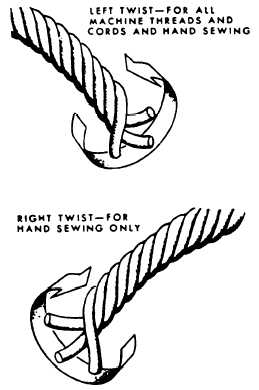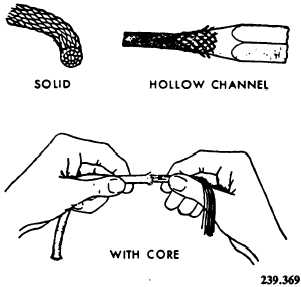the central
239.368
Figure 10-3.—Thread twist.
portion of the letter S, as shown in
figure 10-3.
Cords
Unbraided and braided cords are covered in
the following paragraphs.
UNBRAIDED CORDS.- Unbraided cord is
twisted together in the same manner as thread,
as shown in figure 10-3. The difference between
threads and cords is that cords are stronger and
larger in diameter than threads.
Nylon cords play an important part in the
repairing of life support items. To identify nylon
cord, you must remember that the larger the
number, the larger and stronger the cord.
BRAIDED CORDS.- You know that a braid
is three or more strands of material entwined
together. Cords also come braided, and in two
types: a solid woven cord or a cord with a hollow
channel center, as shown in figure 10-4. Solid
woven cords are flat. Hollow channel cords
sometimes contain several straight, individual
Figure 10-4.—Braided cords..
threads, known as a core. This core increases the
strength of the cord and keeps the outer braided
cover round. Parachute suspension lines are made
from this type of cord.
STORAGE OF TEXTILE MATERIALS
It is necessary to know the general principles
of care and storage of materials because they
differ greatly in their resistance to damage such
as moisture, heat, mildew, fungus, insects, and
rodents. There are certain insects, however, that
will eat almost anything; mice build nests in
almost any kind of stored fabric material; and
there are hundreds of fungus growths that thrive
under moist tropical atmospheric conditions.
Conditions in various parts of the world vary
widely in regard to humidity, heat, or cold, and
the presence of insects. Such conditions must be
taken into account when you are storing and
protecting materials. The following ideal storage
conditions should be attained as nearly as
possible: a dry room with temperature of 70°F,
absence of direct sunlight, a storage room
construction that affords protection against
insects and mice, wooden shelves for storage, and
air conditioning or some other method of
humidity control.
Now let’s consider some of the characteristics
of materials that you should know if you are to
be responsible for keeping them in storage. Nylon
absorbs very little water, dries quickly, is
10-5



